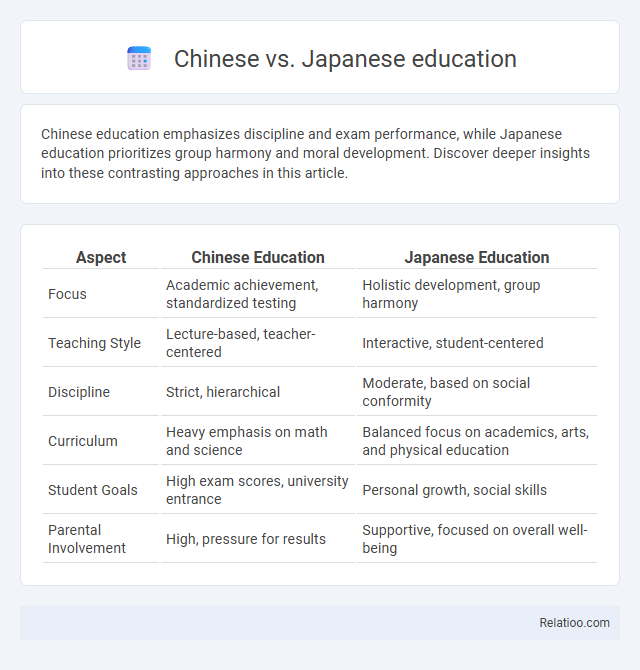Chinese education emphasizes discipline and exam performance, while Japanese education prioritizes group harmony and moral development. Discover deeper insights into these contrasting approaches in this article.
Table of Comparison
| Aspect | Chinese Education | Japanese Education |
|---|---|---|
| Focus | Academic achievement, standardized testing | Holistic development, group harmony |
| Teaching Style | Lecture-based, teacher-centered | Interactive, student-centered |
| Discipline | Strict, hierarchical | Moderate, based on social conformity |
| Curriculum | Heavy emphasis on math and science | Balanced focus on academics, arts, and physical education |
| Student Goals | High exam scores, university entrance | Personal growth, social skills |
| Parental Involvement | High, pressure for results | Supportive, focused on overall well-being |
Overview of Chinese and Japanese Education Systems
The Chinese education system emphasizes rigorous standardized testing and a strong focus on core subjects like mathematics, science, and languages, aiming to prepare students for competitive national exams such as the Gaokao. The Japanese education system prioritizes holistic development, combining academic excellence with moral education, social skills, and extracurricular activities, supporting a well-rounded student experience through mandatory schooling until high school. Your understanding of these educational frameworks highlights the distinct approaches to learning and student expectations in East Asia, influencing academic performance and social development.
Historical Development of Education in China and Japan
The historical development of education in China is deeply rooted in Confucian principles, emphasizing moral cultivation, rote memorization, and civil service examinations that shaped a rigid, hierarchical education system. In contrast, Japan's education system evolved through a blend of indigenous values and Western influences during the Meiji Restoration, leading to a more modern, centralized approach focused on nationalism and industrialization. Your understanding of these distinct educational foundations highlights how cultural and historical contexts influence education expectations and structures in both countries today.
Curriculum Structure: Differences and Similarities
Chinese education emphasizes a rigorous, exam-focused curriculum structured around core subjects such as mathematics, Chinese language, and science, promoting memorization and standardized testing. Japanese education, while also rigorous, incorporates a more holistic curriculum that balances academics with moral education, physical activity, and group activities, fostering social skills and individual development. Both systems aim for high academic achievement but differ in pedagogical approaches, with China prioritizing exam performance and Japan focusing on well-rounded student growth.
Teaching Methods and Classroom Environment
Chinese education emphasizes rote memorization and teacher-centered instruction, fostering discipline and mastery of foundational knowledge, while Japanese education prioritizes group harmony and student participation through interactive and collaborative teaching methods. Classroom environments in China are typically structured and exam-focused, promoting high academic achievement, whereas Japanese classrooms encourage social interaction and moral development alongside academics. Understanding these differences helps you adapt teaching strategies to meet diverse educational expectations effectively.
Role of Examinations and Assessment
Chinese education heavily emphasizes high-stakes examinations as the primary measure of academic success, often determining students' future opportunities and societal status. Japanese education incorporates regular assessments with a balanced approach, valuing not only test scores but also holistic development, including moral education and group harmony. Your understanding of the differing educational expectations highlights how China's rigorous exam culture contrasts with Japan's focus on continuous evaluation and personal growth.
Student Life: Discipline and Expectations
Chinese education emphasizes rigorous discipline with long study hours and a strong focus on rote memorization, fostering resilience and academic excellence. Japanese education balances discipline with group harmony, promoting responsibility through structured routines and collaborative activities. Your student life experience will differ as Chinese students often face intense academic pressure, while Japanese education encourages social conformity alongside high expectations.
Parental Involvement and Social Pressure
Chinese education emphasizes rigorous parental involvement, with parents often investing significant time and resources to ensure academic success, driven by high societal expectations and competitive school environments. Japanese education encourages parental support but balances it with fostering independence in students, amid social pressures that stress group harmony and consistent effort rather than purely academic excellence. Both systems reflect cultural values, where Chinese parental involvement aligns with exam-driven achievement, while Japanese education prioritizes holistic development influenced by social conformity and collective responsibility.
Extracurricular Activities and Holistic Education
Chinese education emphasizes rigorous academics with limited focus on extracurricular activities, often prioritizing exam performance and rote learning. In contrast, Japanese education integrates extracurricular clubs and community involvement to promote holistic development, social skills, and personal growth alongside academics. Educational expectations in Japan value balanced student development, whereas China's system is increasingly recognizing the importance of holistic education but still faces challenges in shifting away from exam-centric approaches.
Educational Outcomes and Global Rankings
Chinese education emphasizes rigorous standardized testing and foundational skills in math and science, leading to consistently high scores in global assessments like PISA, positioning China among the top-ranking countries. Japanese education balances academic excellence with character development and social integration, often reflected in its strong global rankings and holistic educational outcomes. Your understanding of these systems reveals distinct national priorities influencing student performance and expectations in the global academic landscape.
Future Trends and Educational Reforms
Chinese education emphasizes rigorous STEM training and centralized curriculum reforms aimed at innovation-driven growth, while Japanese education focuses on holistic development, creativity, and moral education within a flexible framework; both systems prioritize technological integration and global competence to meet future workforce demands. Educational reforms in China promote digital learning platforms and vocational education expansion, whereas Japan advances personalized learning and internationalization to prepare students for a rapidly changing global environment. Understanding these trends can help you adapt to evolving education expectations and leverage emerging opportunities in Asia's dynamic educational landscape.

Infographic: Chinese vs Japanese education
 relatioo.com
relatioo.com